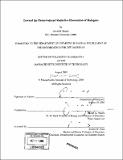Toward the photo-induced reductive elimination of halogens
Author(s)
Manke, David
DownloadFull printable version (7.088Mb)
Other Contributors
Massachusetts Institute of Technology. Dept. of Chemistry.
Advisor
Daniel G. Nocera.
Terms of use
Metadata
Show full item recordAbstract
Light-driven energy conversion schemes have been proposed as alternative energy to fossil fuels. The target fuel of these schemes is hydrogen. For photocatalytic hydrogen production to be feasible, it must be performed on energy-poor substrates and must possess high quantum efficiency. The controlling aspect of this quantum efficiency is not hydrogen evolution, but rather activation of stable M-X bonds that are generated from the reaction of catalyst with the low energy substrate. This thesis examines the activation of such bonds, by examining high oxidation state transition metal dimers as potential platforms for the reductive elimination of halogen. Early transition metals were explored with bis(alkylamido)phenylborane ligands. These systems did not demonstrate halogen elimination, but an interesting transition metal chemistry was developed for this ligand set. Alternatively, bimetallic gold systems were also studied as potential platforms, and have shown efficient photoreactivity toward M-X bond activation.
Description
Thesis (Ph. D.)--Massachusetts Institute of Technology, Dept. of Chemistry, 2005. Vita. Includes bibliographical references.
Date issued
2005Department
Massachusetts Institute of Technology. Department of ChemistryPublisher
Massachusetts Institute of Technology
Keywords
Chemistry.